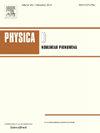Triangular rogue clusters associated with multiple roots of Adler–Moser polynomials in integrable systems
IF 2.9
3区 数学
Q1 MATHEMATICS, APPLIED
引用次数: 0
Abstract
Rogue patterns associated with multiple roots of Adler–Moser polynomials under general multiple large parameters of single-power form are studied in integrable systems. It is first shown that the multiplicity of any multiple root in any Adler–Moser polynomial is a triangular number (i.e., its multiplicity is equal to for a certain integer ). Then, it is shown that corresponding to a nonzero multiple root of the Adler–Moser polynomial, a triangular rogue cluster would appear on the spatial–temporal plane. This triangular rogue cluster comprises fundamental rogue waves forming a triangular shape, and space–time locations of fundamental rogue waves in this triangle are a linear transformation of the Yablonskii–Vorob’ev polynomial ’s root structure. In the special case where this multiple root of the Adler–Moser polynomial is zero, the associated rogue pattern is found to be an th order rogue wave in the neighborhood of the spatial–temporal origin. These general results are demonstrated on two integrable systems: the nonlinear Schrödinger equation and the generalized derivative nonlinear Schrödinger equation. For these equations, asymptotic predictions of rogue patterns are compared with true rogue solutions and good agreement between them is illustrated. The present results generalize the earlier ones in the literature where only one of the parameters was assumed large. Extension of these results to generic multiple large parameters of dual-power form is also discussed.
可积系统中与Adler-Moser多项式多根相关的三角形流氓簇
在可积系统中,研究了一般多重大参数单幂形式下Adler-Moser多项式的多重根相关的不规则模式。首先证明了任一Adler-Moser多项式中任一重根的多重性是一个三角数(即对于某整数n,其多重性等于n(n+1)/2)。然后,证明了对应于Adler-Moser多项式的非零多次根,在时空平面上会出现一个三角形的流氓簇。这个三角形不规则星团由n(n+1)/2个基本不规则波组成一个三角形,基本不规则波在这个三角形中的时空位置是Yablonskii-Vorob ' ev多项式Qn(z)的根结构的线性变换。在Adler-Moser多项式的多重根为零的特殊情况下,发现相关的异常模式是时空原点的O(1)邻域的n阶异常波。这些一般结果在两个可积系统:非线性Schrödinger方程和广义导数非线性Schrödinger方程上得到了证明。对于这些方程,将流氓模式的渐近预测与真流氓解进行了比较,并说明了它们之间的良好一致性。目前的结果推广了文献中早期的结果,其中只有一个参数被假设为大。并讨论了将这些结果推广到双幂型的一般多重大参数。
本文章由计算机程序翻译,如有差异,请以英文原文为准。
求助全文
约1分钟内获得全文
求助全文
来源期刊

Physica D: Nonlinear Phenomena
物理-物理:数学物理
CiteScore
7.30
自引率
7.50%
发文量
213
审稿时长
65 days
期刊介绍:
Physica D (Nonlinear Phenomena) publishes research and review articles reporting on experimental and theoretical works, techniques and ideas that advance the understanding of nonlinear phenomena. Topics encompass wave motion in physical, chemical and biological systems; physical or biological phenomena governed by nonlinear field equations, including hydrodynamics and turbulence; pattern formation and cooperative phenomena; instability, bifurcations, chaos, and space-time disorder; integrable/Hamiltonian systems; asymptotic analysis and, more generally, mathematical methods for nonlinear systems.
 求助内容:
求助内容: 应助结果提醒方式:
应助结果提醒方式:


